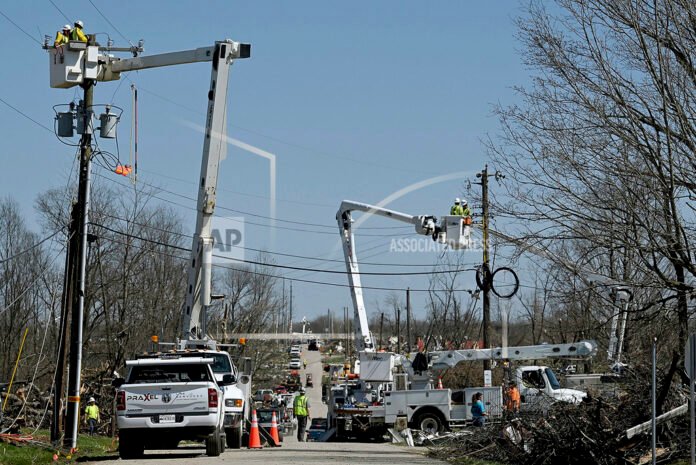
DES MOINES, Iowa (AP) — People still sorting through the wreckage of their homes after deadly weather hit over the weekend braced for another wave of strong storms, likely including tornadoes, that were expected in parts of the Midwest and South beginning Tuesday evening. Officials warned residents to have shelter ready before going to sleep.
“This could be a night to just set up down in the basement to be safe,” said Tom Philip, a meteorologist in Davenport, Iowa.
The storms were expected to hammer some areas hit by severe weather and possibly dozens of tornadoes that killed at least 32 people, meaning more misery for those whose homes were destroyed in Arkansas, Iowa and Illinois. Dangerous conditions Tuesday also could stretch into parts of Missouri, southwestern Oklahoma and northeastern Texas. Farther south and west, fire danger will remain high.
“That could initially start as isolated supercells with all hazards possible — tornadoes, wind and hail — and then over time typically they form into a line (of thunderstorms) and continue moving eastward,” said Ryan Bunker, a meteorologist with the National Weather Center in Norman, Oklahoma.
Hours before the biggest storms were expected to hit, strong thunderstorms swept through the Quad Cities area of Iowa and Illinois on Tuesday morning with winds up to 90 mph (145 kph) and baseball size hail. No injuries were reported but trees were downed and some businesses were damaged in Moline, Illinois.
Northern Illinois, from Moline to Chicago, was seeing 75-80 mph (120-128 kph) winds and hail 2 to 3 inches (5 to 8 centimeters) in diameter on Tuesday afternoon, National Weather Service meteorologist Scott Baker said.
“People can be injured with hail that size, and so can animals,” Baker said.
The agency also received reports of semi trucks tipped over by winds in Lee County, about 95 miles (153 km) west of Chicago.
The tornado risk in the Upper Midwest was expected to be highest in the late afternoon and evening Tuesday with storms targeting northern Illinois, eastern Iowa and southwest Wisconsin. Areas of southern Missouri and Arkansas were most at risk overnight.
In Keokuk County, Iowa, where 19 homes were destroyed and more were damaged Friday, emergency management official Marissa Reisen worried how those cleaning up the damage will cope if another storm hits.
“All of the people who have been impacted by the storms Friday night are doing all this work, to clean up, to gather their stuff, to pile up the debris,” Reisen said. “If a storm comes through and hits them again and throws all that hard work all over the place again, it will be so deflating to those people.”
Severe storms could produce strong tornadoes and large hail Wednesday across eastern Illinois and lower Michigan and in the Ohio Valley, including Indiana and Ohio, according to the Storm Prediction Center. The weather threat extends southwestward across parts of Kentucky, Missouri, Tennessee and Arkansas.
The fierce weekend storms spawned deadly tornadoes in 11 states as the system plodded through Arkansas and onto the South, Midwest and Northeast.
The same conditions that fueled those storms — an area of low pressure combined with strong southerly winds — will make conditions ideal for another round of severe weather Tuesday into early Wednesday, Bunker said.
Those conditions, which typically include dry air from the West going up over the Rockies and crashing into warm, moist air from the Gulf of Mexico, are what make the U.S. so prone to tornadoes and other severe storms.
A blizzard warning was in effect for nearly all of North Dakota and most of South Dakota through at least Wednesday night. The National Weather Service predicted parts of South Dakota could see up to 16 inches (40 centimeters) of snow and wind gusts as high as 55 mph (90 kph).
Dozens of schools in South Dakota were closed on Tuesday due to blizzard conditions. State executive branch offices were also closed in much of the state.
North Dakota Gov. Doug Burgum signed off on $20 million Tuesday for emergency snow removal grants to localities. Officials reminded residents to check on neighbors and keep their homes stocked with food, water and medicine, have battery-powered radios in case of power outages and ensure gas meters and furnace vents are clear of snow.
In Minnesota, a winter storm warning was in effect in the north, while the southern part of the state expected thunderstorms that could include hail and strong winds. The expected weather led the Minnesota Twins to delay their Major League Baseball home opener from Thursday to Friday.
The state’s popular EagleCam captured the moment on Sunday morning in which high winds blew a 20-year-old eagle’s nest out of a tree, killing an eaglet that had hatched just days earlier. Officials believed heavy snow that fell in a weekend blizzard — coupled with the weight of the more than 2,000-pound nest — became too much for the tree to support.
Fire danger persisted across portions of far western Oklahoma, the Texas Panhandle, northeastern New Mexico and far southeastern Colorado, with low humidity, dry vegetation and high wind gusts. Officials issued a fire warning for Custer County in western Oklahoma and urged some residents near the town of Weatherford to evacuate their homes because of a wildfire that was moving quickly.
___
Associated Press writers Trisha Ahmed in St. Paul, Minn., Margery A. Beck in Omaha, Neb., and Claire Savage in Chicago contributed to this report.
Photo: Lineman work to reestablish the power in a neighborhood that was damaged by a recent tornado on Monday, April 3, 2023, in Sullivan, Ind. (Joseph C. Garza/The Tribune-Star via AP)


